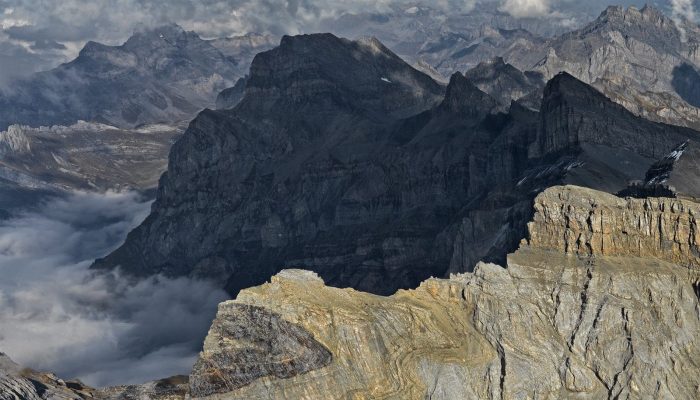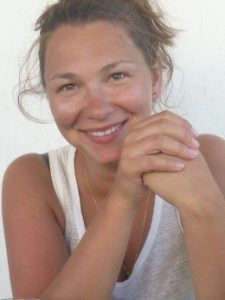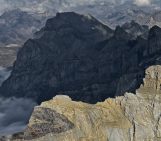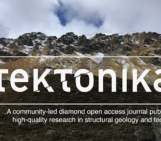
Following our previous blog about the EGU journal Solid Earth, we now would like to share some experiences of open access publishing in this journal with you. Therefore, we interviewed Anna Rogowitz, who recently published in Solid Earth, about her experiences.
 About Anna:
About Anna:
Anna is an Assistant Professor in the Structural Processes Group at the Department of Geodynamics and Sedimentology (University of Vienna, Austria) since December 2015. She finished her MSc degree in geology in the beginning of 2011 at the Institute of Geology, Mineralogy and Geophysics (Ruhr-University Bochum, Germany). Anna then carried on to a PhD in the field of structural geology with focus on strain rate dependent calcite deformation (Department of Geodynamics and Sedimentology, University of Vienna); using field observations in combination with detailed microfabric analyses to study strain localization processes in the lithosphere, with special focus on the ductile regime. Anna is also presently part of our TS ECS team.
1. You recently published a very interesting paper in Solid Earth. In three or four sentences, what is it about?
Thanks! The study was part of my PhD thesis in which I analysed the isotopic and mechanical impact of strain localization in a calcite marble at varying strain rates. The manuscript is dealing with the simultaneous activation of grain boundary sliding (GBS) and dislocation motion as a powerful strain softening mechanism in calcite. We analysed a pretty highly strained calcite marble and observed grain size reduction by bulging recrystallization, resulting in an almost strain-free ultramylonite that got subsequently deformed by dislocation activity, with clear evidence for GBS. The combination of these two mechanisms has been recently discussed more often for experimentally deformed rocks (Wang et al., 2010; Hansen et al., 2011). For us it was a bit surprising, as the deformation occurred at high differential stresses, relatively low temperatures and strain rates of nearly 10-9 s-1. At these conditions, brittle deformation could be anticipated rather than ductile behaviour.
2. Why did you choose Solid Earth?
One of the Editors, Luca Menegon (Plymouth University) was a visiting professor at our department while I was working on the study. We discussed our findings and he suggested that I submit the work to Solid Earth, as they were working on a Special Issue on ‘Deformation mechanisms and ductile strain localization in the lithosphere’ at that point. The topic of the Special Issue fit perfect to our results, so it was pretty easy to decide for Solid Earth.
3. Did the fact that it is an open access journal contribute to your decision?
Definitely! I like the idea of research being accessible for everybody who is interested.
I know some colleagues that have access to only a very limited number of journals. Of course there is always the possibility to write an e-mail to the author and ask for a copy of a specific manuscript but I also know that especially young researchers might be too shy or afraid to do so. Another reason for choosing an open access journal was that part of my study was funded by the Austrian Science Fund (FWF) and open access publications are mandatory.
4. EGU journals have a very transparent peer-review process in which reviews and author replies are posted online. How did you experience this?
I think the idea of an open review process, where people interested in a specific topic can discuss a manuscript is great. Honestly, I would have liked more people to join the discussion on our publication. I think it helps to improve the quality of a manuscript and could also help to connect people. Maybe even result in more interdisciplinary studies.
5. As an early career researcher, what are the most important things you look for when choosing a journal to submit a paper to?
I always go with some suggestions to my co-authors and discuss with them what would be the best choice for our manuscript. One of the most important factors for me is if it is a journal that I read regularly and preferably has open access. As an early career researcher but not that young/early anymore I have to admit that the impact factor starts to play a more important role. And of course the publication costs. I prefer to spend my funding on research and analyses than the journal I publish in.
6. Do you have suggestions for improvements concerning the submission, review and publication process in Solid Earth?
I thought that it was a bit time consuming that the submitted manuscript got edited as a discussion paper before it went into the review process. Also the fact that we had to pay for the preparation of the discussion paper even though it might have possibly been rejected was something I disliked. But from what I understood, these two things have been changed already. Another thing is that I would like the entire review process to be public. Of course the discussion and review process has to stop at some point but I think it would be nice if this is not before the final decision by the editor has been made. I would like that further exchanges by editor and authors could also be followed and commented on by the community.
7. Do you have recommendations for authors who are considering publishing in Solid Earth?
Hah! Beside ‘Go for it’… No, I really think that Solid Earth is a great journal that covers a broad field of Earth sciences. The fact that it is open access and affordable (even for early career scientists that may not have a lot of funding) is a big plus. And different to some other journals, the review process is pretty fast, which nowadays is a very important factor. Personally, I would definitely consider to submit another publication to Solid Earth. Probably, I would try to motivate a few more people to comment on the manuscript during the peer-review process. Some people have started to announce their discussion papers in the Geo-Tectonics forum, which is a very smart idea.
Paper’s reference:
Rogowitz, A., White, J.C., and Grasemann, B., 2016. Strain localization in ultramylonitic marbles by simultaneous activation of dislocation motion and grain boundary sliding (Syros, Greece). Solid Earth 7, 355-366, Doi:10.5194/se-7-355-2016
This blog was established as a group effort of the T&S team.


